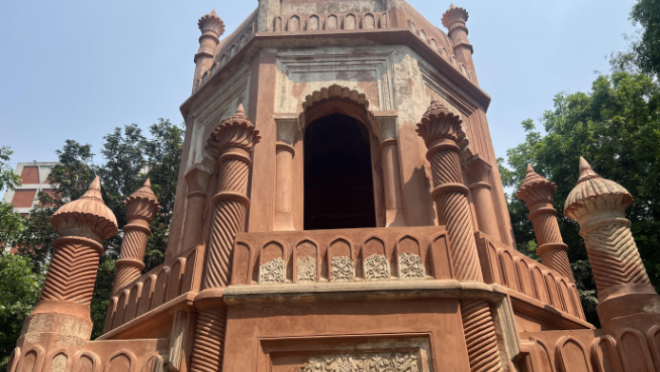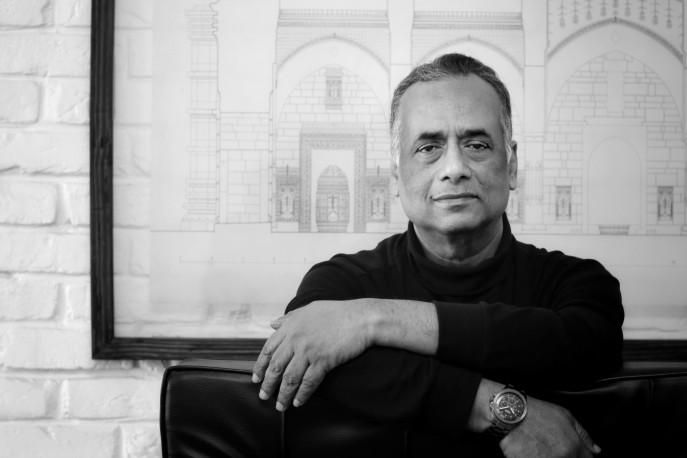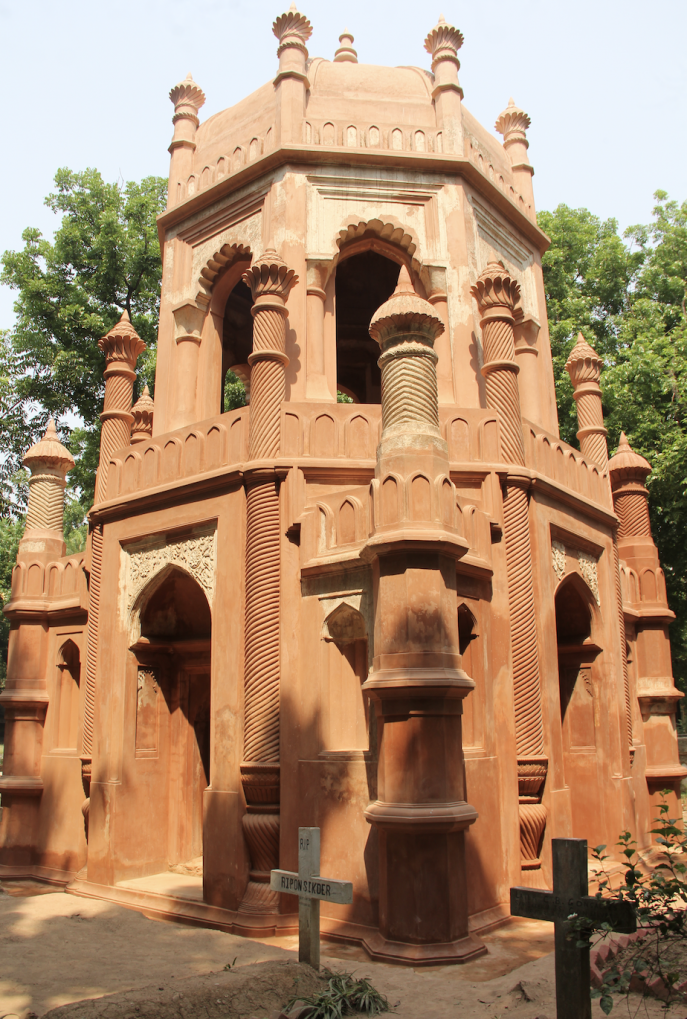The mystery of Colombo Sahib’s tomb—restored to its former glory
The mystery of Colombo Sahib’s tomb—restored to its former glory

Back in 1824, when Bishop Heber visited Dhaka, he found the Narinda cemetery overgrown and wild. Yet amidst the thick greenery, one tomb caught his eye. It was too grand to simply walk past without a second glance. Its base followed Islamic architectural style, the second story leaned Gothic, and the dome was all Baroque flair. At first glance, it looked like the shrine of a Muslim Sufi saint.
Curious, Heber asked the elderly caretaker whose grave it was. The man answered, “Ye Colombo Sahib ka maqbara, Company ka naukar” — ‘It’s the tomb of Colombo Sahib, a servant of the Company.’
That was the only clue. And yet, the name didn’t sound particularly British to Heber, and there was no inscription to confirm it. Thus began a two-hundred-year-old mystery.
So, who exactly was Colombo Sahib?
Historians, archaeologists, and art historians, both local and foreign, have spent years chasing answers. Which ‘Company’ did he serve? Was he British or Dutch East India Company? When exactly was this imposing structure built?
After all, Bengal was once home to Portuguese, Dutch, French, English, and more—but none of their names seem to fit ‘Colombo.’ Only in Portuguese is ‘Columbus’ pronounced ‘Colombo,’ and even today, people with that surname can be found in America and Canada.
It’s an interesting clue, but not enough to settle the matter.

Tim Steel, an archaeologist who spent some time in Dhaka, had a theory: Colombo Sahib could have been a wealthy merchant from Colombo (modern-day Sri Lanka) who came to Dhaka to trade, and because of his place of origin, he became known simply as ‘Colombo Sahib.’
Meanwhile, British historian Dr Rosie Llewellyn-Jones suggests he might have been sent by the Dutch East India Company from Sri Lanka to oversee their business in Dhaka.
She points to examples from Surat, a major Mughal port, where European cemeteries often had Islamic-style tombs—because back then, imitating Mughal architecture was a way to showcase class and prestige.
Restoration work underway
Recently, the British Association for Cemeteries in South Asia (BACSA) suggested another possibility. In their journal Chowkidar, they argued that Colombo Sahib was actually Clarembolt, the British East India Company’s Factory Chief. Over time, the name supposedly morphed into ‘Colombo.’ Clarembolt is said to have died in 1755.

But even this doesn’t solve everything neatly. Among the tomb’s surviving inscriptions, the oldest belongs to a Dutch Factory Chief, William Kirkman, who died in 1773. Incidentally, his wife’s name was Corombo. Coincidence? Perhaps.
What most researchers agree on is that the tomb dates back to the transition between the late Mughal period and the early colonial era—meaning it’s over 350 years old.
A key piece of evidence is a painting from 1787 by artist Johann Zoffany titled Nagaphan Ghat, where the tomb is clearly visible. And surviving for 350 years in our tropical weather is no small feat. Over the centuries, the tomb suffered greatly—weathered walls, invasive banyan trees, wild weeds. Restoration became a necessity.
Answering the call to restore
Architect Waqar A Khan has spent years researching colonial-era structures in Bangladesh, helping both local and foreign historians alike. For eight long years, he quietly worked to unravel the Colombo Sahib mystery.
As the local representative for BACSA, he invited Professor Dr Abu Sayeed M Ahmed to take on the task of conserving the tomb back in 2012.
Dr Sayeed Ahmed, a conservation architect, studied architecture at BUET before heading to Germany in the early ’90s for his PhD. He carried with him a copy of Dr Enamul Haque’s Islamic Heritage of Bangladesh.
At that time, Europeans mostly thought of Bangladesh as a land of famine and poverty. Seeing the heritage showcased in the book—ancient mosques dating back to the 13th and 14th centuries—left many of them astonished. One Scottish lad even remarked, “We celebrate a wall from the 16th century in Edinburgh, and you have structures many times older!”
That made Sayeed Ahmed realise: if we don’t preserve our heritage, it’ll be lost forever.
Back then, universities in Bangladesh didn’t teach much about Bengal’s own architectural history or conservation methods. Students learned about Egypt, Mesopotamia, Baroque, Gothic, and Renaissance styles—but hardly anything about Bengal’s past.
Sayeed decided to make it his life’s work: documenting the history of Bengal’s architecture and mastering conservation techniques.
Gaining hands-on experience
After returning home with his PhD, he joined the University of Asia Pacific’s architecture department in 1997. His first real conservation opportunity came a little later, during Dhaka’s 400-year celebration, when he was tasked with restoring the Nimtali Deuri gateway.
Although full restoration wasn’t possible, the project gave him invaluable practical experience.
Later, while working on the massive Boro Sardarbari project in Sonargaon—a project funded by South Korean company Youngone Corporation as part of their corporate social responsibility—he put those lessons to good use.

Sayeed recalls, “You hardly ever see local or foreign corporate houses funding heritage conservation projects. Youngone’s initiative deserves special mention; it’s a model for how corporate support can play a role in preserving history.”
The Boro Sardarbari project involved a hundred skilled craftsmen over three years. Curious about the process, we asked Sayeed how conservation work is typically carried out.
He explained, “We always start with a thorough survey. First comes the drawing phase—to understand the building’s plan, elevation, and proportions. Then we do photometry, where we stitch together detailed photographs of the façade. This helps us capture intricate decorations and designs.
Next is videography, followed by an archival survey—researching the building’s history, era, and contemporary architecture.
Finally, we prepare a conservation drawing that outlines exactly what parts need repairing or restoring. After all that, we estimate the budget and seek funding.”
As of now, about 75% of Colombo Sahib’s tomb restoration is complete—and if all goes well, soon this beautiful piece of Dhaka’s hidden history will be standing tall once again.
Since Sayeed Ahmed has long been a faculty member at the University of Asia Pacific, many students have worked with him. He and his students conducted the survey, then prepared the budget and sent it through Wakar Khan to Baksa in 1912. Baksa approved just one-fourth of the total budget. However, it took another 12 years to gather the necessary funds.
The craftsmanship of the Masons
In 1924, after the final proposal was sent, work finally began last September. The first task was clearing the jungle. The banyan tree was the biggest concern. From a distance, it seemed like it would collapse the moment its roots were disturbed. Fortunately, the roots did not go deep, making the process easier.
Sayeed Ahmed then brought six masons from Natore and Paharpur. Speaking about this, Mr. Ahmed mentioned, “People in different districts of our country have varied skills. For example, people from Paharpur are good at making floral patterns on bricks, people from Natore are skilled in ornamentation, and those from Chapainawabganj excel at brickwork. Some people from Old Dhaka are also experts in working with porcelain shards. Through our work, we’ve developed close relationships with these skilled individuals. We are like one big family now.”
He continued, “It would be a mistake to categorize masons as ordinary craftsmen. Hidden within them is the heart of an artist. Let me give you an example. Once, there was a need to repair a ceramic work at a monument. I thought about making a plate with an old ceramic design at any ceramic industry. However, when I asked around in Old Dhaka, they told me, ‘We don’t need you to make the plate.

We’ll gather it for you.’ They took us to the shrine of Pir Yameni in Gulistan. The exterior of the shrine was once entirely covered with porcelain work, but the shrine committee had replaced it with modern tiles. But the craftsmen didn’t discard the porcelain shards; instead, they stored them carefully in a sack and buried them underground nearby. They gave us a sack of those shards. To the committee, they might not have been valuable, but to an artist, they are worth more than gold. I’ve also observed that masons, when encountering a snake, do not kill it; they simply throw it away. I have never heard of a mason being bitten by a snake. There’s so much to learn from them. Unfortunately, their way of survival is being eroded.”
Before restoration: A photograph from 1875
Six craftsmen, aware of the original construction techniques, worked with Sayeed Ahmed and 12 other skilled artisans on the Colombo Sahib project. During the restoration, Sayeed Ahmed remained meticulous to ensure no mistakes were made. Returning the structure to its original design was his task; adding something new was not. His work was guided by clear examples. In this case, Wakar Khan’s research was helpful. He provided an 1875 photograph taken by the Johnston and Hoffman Studio in Kolkata. A 1850 photograph was also found. These images became key references for the restoration process.
Thanks to the surviving parts, photographs, and paintings by Jofani, the Colombo Sahib’s tomb is now largely visible.
Restoring for the love of tradition
Sayeed Ahmed and his students worked on the restoration with passion, driven by the desire to preserve tradition. Financial gain was not the primary concern. However, wages for the masons and the cost of materials were necessary. Some progress was made using the funds provided by Baksa, but additional funds were needed, so an application was made to the Commonwealth Heritage Foundation.
In the meantime, to ensure the work did not stall, Father Albert from Kakrail Church in Dhaka and Sayeed Ahmed personally contributed some funds. The Commonwealth Heritage Foundation’s grant has recently arrived, and in the past few months, 75% of the work has been completed. The remaining 25% involves marking and preserving the inner graves and constructing roads, plazas, or platforms around the tomb. Sayeed Ahmed hopes to complete everything within two months.
On the construction materials used
At one point, Sayeed Ahmed was asked what materials were used in the restoration of the monument. He explained, “Since most experts agree that the construction dates back to the late Mughal period, we used brick powder and lime. The Mughals’ main administrative center was in Delhi, and red sandstone was easily available there, but it was scarce here. However, the Subedars of Dhaka wanted to build structures similar to those in Delhi or Agra, so they discovered the chemistry of lime mortar, which naturally gives buildings a red hue. The color depends on the lime mixture, which can range from light to dark red. To bond the materials, we used ingredients like Kalai branches, molasses, and areca nut extract.”
Restoration and the importance of reuse
Since 2008, Sayeed Ahmed has restored or rebuilt 14 monuments. At times, he has also played the role of an activist. He regularly writes in newspapers and presents papers on Bangladesh’s heritage architecture and the need for its conservation at seminars both locally and abroad. Across both public and private sectors, 26 universities in the country now teach and research architectural history and conservation. Each year, two to three students in every university work on theses about historic architecture, so the subject is no longer new, and interest is growing.
Recently, Sayeed Ahmed restored an old house in Alfadanga, Faridpur. The house was originally built by the ancestors of an influential family. Over time, parts of it had collapsed, and the family wanted to preserve the memory of their forebears while also creating a space for leisure. Sayeed Ahmed returned it to its former glory. The house is now also being used as a resort, and both local and foreign guests prefer staying there.
Sayeed Ahmed also mentioned that AK Khan Group, one of the country’s top business conglomerates, has shown interest in finding and restoring heritage buildings across various districts to convert them into coffee shops. Speaking of this trend, he said, “We all know about Rajasthan’s example, where heritage buildings have been transformed into five-star hotels or convention centers. The chance of private heritage buildings surviving increases when there is a potential for revenue. We have hundreds of such buildings in our country. I have restored 13 or 14 buildings so far, and maybe I can restore another six or seven. The younger generation will take up the rest, but for that, we need clear policies and a path for funding.”
Final thoughts on Colombo Sahib
Let’s return to Colombo Sahib. The old caretaker shared his history, but the written record has been buried by time. Whether it will ever be recovered remains uncertain, as Wakar Khan’s concern might prove true: “It will likely remain as it is, and the mystery of Colombo Sahib will only grow as time passes.” However, the restoration has extended the lifespan of this monument, providing some comfort to the researchers.


